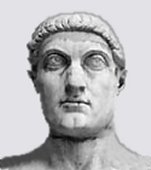|
|

|
|
Constantine I
(ca. 280-337), baptized on his deathbed, was the first Christian Roman emperor. In the Eastern part of his empire, he created a “new Rome” when he moved the capital to Byzantium, which he renamed Constantinople (city of Constantine). Under his successors, Christianity became the empire’s state religion and imposed its view of human sexuality on both Eastern and Western Europe.
|
|
|
In the 4th century A.D., Constantine I (“the Great”) became the first Christian Roman emperor, and under his successors Christianity became the empire’s state religion. As a result, Europe gradually adopted a Christian view of human sexuality. Based on an older Jewish tradition and influenced by certain ascetic ancient philosophies, this view prevailed even after the fall of the Roman Empire and then dominated the Western world and its colonies well into the modern age. According to the Christian doctrine, sexual activity was justified only for the purpose of procreation. All forms of sexual intercourse that could not serve this purpose were sinful. Indeed, some of them, like oral and anal intercourse, or sexual contact with animals or between males, were so abominable that, for many centuries, they were severely punished as crimes. It was not until about 200 years ago that some European countries began to remove religious influences from their penal codes and ceased to punish sexual “abominations”: If no concrete harm had been done to another person, the law simply ignored the behavior.
However, where the law retreated, medicine soon stepped in. The emerging specialty of psychiatry turned the old sins into new mental illnesses, and thus the “abominations” were reborn as “sexual psychopathologies”. The psychiatrists even used the old theological terms “perversion”, “aberration”, and “deviation” to characterize these illnesses. In the Middle Ages, the terms had referred to heresies, i.e. “false” religious beliefs, now they meant “false” sexual behaviors, and thus the former heretics and criminals turned into medical patients. These did not need punishment, but therapy. It was only in the late 20th century that the medical profession finally followed the example of the jurists and removed the theological vestiges from its diagnostic handbooks. The newly “enlightened” doctors now discovered that their uncritical adoption of religious ideas and terms had been moralistic and prescientific. Therefore, they tried to find objective criteria for judging sexual behavior. They also no longer wanted to speak of “perversions” etc. and looked for new, purely descriptive, morally neutral terms.
|


